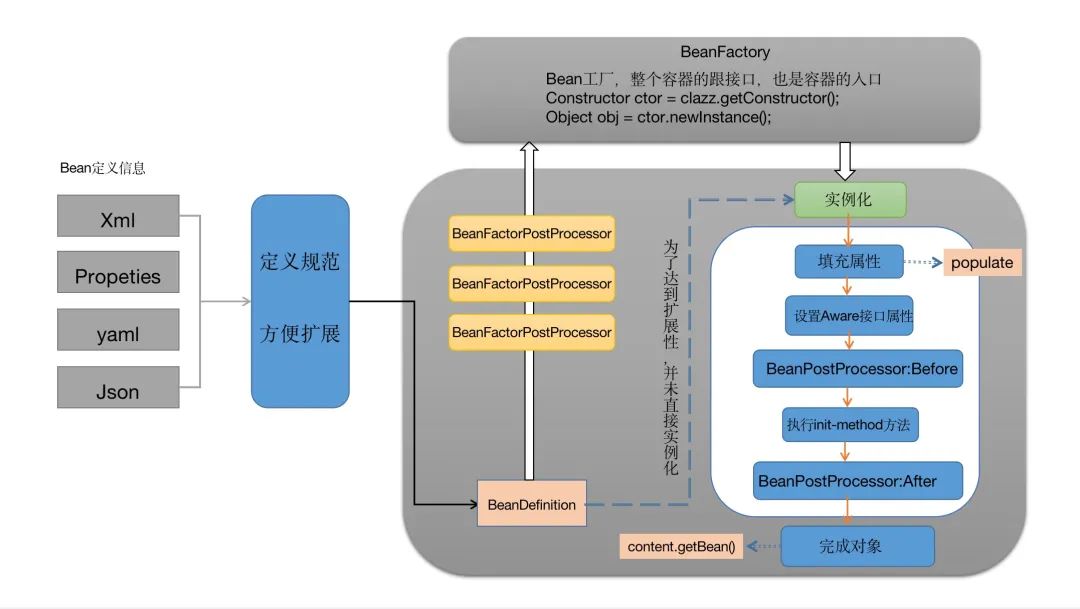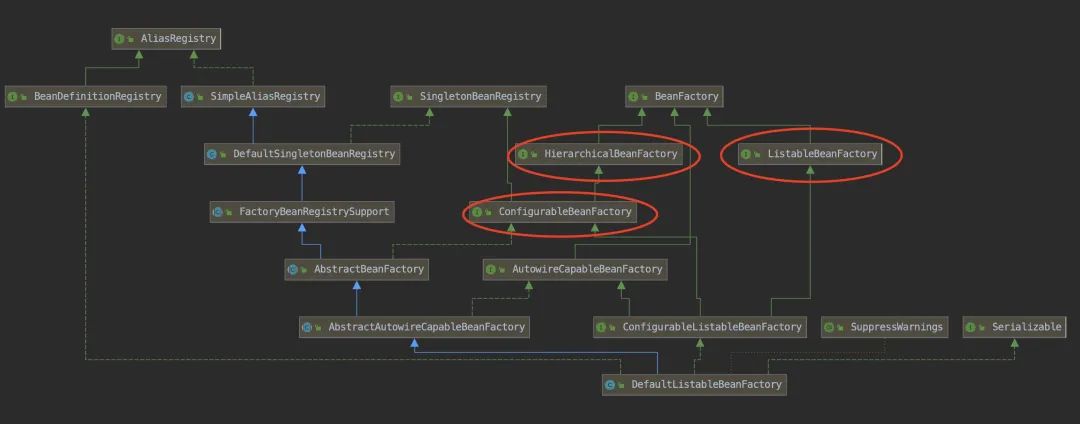Spring创建Bean的过程Debug
点击上方蓝色字体,选择“标星公众号”
优质文章,第一时间送达
作者 | x1aoda1
来源 | urlify.cn/QzYFba
Spring流程Debug
1.1 Spring测试环境搭建
Spring模块概览,绿色是模块,Spring中八大模块,黑色表示该模块包含的jar包(组件)。例如我们想要用IOC容器,也就是绿色的CoreContainer,我们需要导入Beans,Core,Context,SpEL(spring-expression)四个包。

Test:测试相关
Core Container:IOC容器
AOP:面向切面编程
Aspects:切面
Instrumenttation:跟JDK关联,一般不用
Messaging:消息服务,一般不用
Data Access/Integration:数据访问与集成(JDBC访问,Transaction事务,ORM对象关系映射,OXM和XML映射一般不用,JMS为Java消息服务Java-message-service一般不用)
Web:Web服务(WebSocket网络通信协议,Servlet, Web,Portlet一般不用)
最偷懒的方式,是直接导入Spring-Framework。但是可能导入不必要的包,导致项目打包后比较大
由于Spring-Content中的ApplicationContent是整个IOC的入口。我们导入Spring-context包即可
org.springframework
spring-context
5.2.3.RELEASE
我们导入spring-content后,默认会导入该组件的依赖jar,spring-content底层的依赖可以看到,实际上我们是导入了Core Container模块:
org.springframework
spring-aop
5.2.3.RELEASE
compile
org.springframework
spring-beans
5.2.3.RELEASE
compile
org.springframework
spring-core
5.2.3.RELEASE
compile
org.springframework
spring-expression
5.2.3.RELEASE
compile
新建Spring配置文件spring.xml:
"1.0" encoding="UTF-8"?>
"http://www.springframework.org/schema/beans"
xmlns:xsi="http://www.w3.org/2001/XMLSchema-instance"
xsi:schemaLocation="http://www.springframework.org/schema/beans http://www.springframework.org/schema/beans/spring-beans.xsd">
"hello" class="com.xiaodai.service.Hello">
"id" value="1">
"name" value="zhangsan">
"age" value="18">
编写测试类:
import com.xiaodai.service.Hello;
import org.springframework.context.ApplicationContext;
import org.springframework.context.support.ClassPathXmlApplicationContext;
public class Test {
public static void main(String[] args) {
ApplicationContext applicationContext = new ClassPathXmlApplicationContext("spring.xml");
Hello hello = applicationContext.getBean("hello", Hello.class);
System.out.println(hello.getName());
}
}
1.2 Debug容器创建过程
从测试类的new ClassPathXmlApplicationContext("spring.xml")开始debug,进入ClassPathXmlApplicationContext,可以看到:
public ClassPathXmlApplicationContext(
String[] configLocations, boolean refresh, @Nullable ApplicationContext parent)
throws BeansException {
super(parent);
// 设置配置文件路径
setConfigLocations(configLocations);
if (refresh) {
// 核心步骤
refresh();
}
}
加载配置文件后,进入refresh()方法,该方法是容器初始化的核心步骤。该方法包含十三个方法:
@Override
public void refresh() throws BeansException, IllegalStateException {
synchronized (this.startupShutdownMonitor) {
// Prepare this context for refreshing.
/**
* 准备刷新,做一些最基本的准备化工作
**/
prepareRefresh();
// Tell the subclass to refresh the internal bean factory.
/**
* 获得一个刷新的bean容器,实质就是获取工厂。
* 加载xml等配置文件,用该文件产生的BeanDefinition来创建一个工厂
**/
ConfigurableListableBeanFactory beanFactory = obtainFreshBeanFactory();
// Prepare the bean factory for use in this context.
/**
* 准备bean工厂
**/
prepareBeanFactory(beanFactory);
try {
// Allows post-processing of the bean factory in context subclasses.
// 后置增强,方便扩展
postProcessBeanFactory(beanFactory);
// Invoke factory processors registered as beans in the context.
// 实例化并且执行BeanFactoryPostProcessors
invokeBeanFactoryPostProcessors(beanFactory);
// Register bean processors that intercept bean creation.
// 实例化并且注册所有的BeanPostProcessor
registerBeanPostProcessors(beanFactory);
// Initialize message source for this context.
// 国际化设置,一般用不到
initMessageSource();
// Initialize event multicaster for this context.
// 初始化应用程序的多波器和广播器
initApplicationEventMulticaster();
// Initialize other special beans in specific context subclasses.
// 空方法,预留给子类做扩展
onRefresh();
// Check for listener beans and register them.
// 注册监听器
registerListeners();
// Instantiate all remaining (non-lazy-init) singletons.
// 工作中常用,面试常问。实例化所有非懒加载的实例对象
finishBeanFactoryInitialization(beanFactory);
// Last step: publish corresponding event.
// 完成刷新
finishRefresh();
}
catch (BeansException ex) {
if (logger.isWarnEnabled()) {
logger.warn("Exception encountered during context initialization - " +
"cancelling refresh attempt: " + ex);
}
// Destroy already created singletons to avoid dangling resources.
destroyBeans();
// Reset 'active' flag.
cancelRefresh(ex);
// Propagate exception to caller.
throw ex;
}
finally {
// Reset common introspection caches in Spring's core, since we
// might not ever need metadata for singleton beans anymore...
resetCommonCaches();
}
}
}
1.3 AbstractApplicationContext的refresh()包含的13个方法分析
结合概览图一个一个方法分析:

方法1:prepareRefresh() => 准备工作
准备刷新,做一些最基本的准备化工作
protected void prepareRefresh() {
// Switch to active.
// 设置开始时间
this.startupDate = System.currentTimeMillis();
// 关闭状态设置为false
this.closed.set(false);
// 活跃状态设置为true
this.active.set(true);
// 打印日志
if (logger.isDebugEnabled()) {
if (logger.isTraceEnabled()) {
logger.trace("Refreshing " + this);
}
else {
logger.debug("Refreshing " + getDisplayName());
}
}
// Initialize any placeholder property sources in the context environment.
// 初始化属性资源
initPropertySources();
// Validate that all properties marked as required are resolvable:
// see ConfigurablePropertyResolver#setRequiredProperties
// 获取环境信息,验证属性信息
getEnvironment().validateRequiredProperties();
// Store pre-refresh
// 存储预刷新的一些应用信息的监听器
ApplicationListeners...
if (this.earlyApplicationListeners == null) {
this.earlyApplicationListeners = new LinkedHashSet<>(this.applicationListeners);
}
else {
// Reset local application listeners to pre-refresh state.
this.applicationListeners.clear();
this.applicationListeners.addAll(this.earlyApplicationListeners);
}
// Allow for the collection of early ApplicationEvents,
// to be published once the multicaster is available...
// 创建一些监听器事件的集合
this.earlyApplicationEvents = new LinkedHashSet<>();
}
总结:1.设置启动事件 2.设置关闭活跃的状态 3.获取环境对象并设置属性值 4.设置监听器以及需要发布事件的集合
重要的点:
获取环境信息,验证属性信息,getEnvironment().validateRequiredProperties();
存储预刷新的一些应用信息的监听器,在Spring中是空实现,但是SpringBoot中,是有具体的值的
方法2:obtainFreshBeanFactory() => 获得一个刷新的bean容器
获得一个刷新的bean容器,实质就是获取工厂。创建容器对象DefaultListableBeanFactory;加载xml配置文件的属性到当前的工厂中,最重要的就是BeanDefinition

AbstractRefreshableApplicationContext:
// 只要进到这个方法,那么我们创建的一定是一个新的工厂
@Override
protected final void refreshBeanFactory() throws BeansException {
if (hasBeanFactory()) {
// 如果存在先销毁,后关闭
destroyBeans();
closeBeanFactory();
}
try {
// 创建bean工厂,这里使用的就是DefaultListableBeanFactory。此时创建的工厂里面的属性值都是默认值
DefaultListableBeanFactory beanFactory = createBeanFactory();
// 序列化id
beanFactory.setSerializationId(getId());
// 设置一些属性值
customizeBeanFactory(beanFactory);
// 加载bean的定义属性值。该方法有很多重载,非常复杂,核心是do操作
// 完成配置文件或者配置类文件的加载
loadBeanDefinitions(beanFactory);
synchronized (this.beanFactoryMonitor) {
this.beanFactory = beanFactory;
}
}
catch (IOException ex) {
throw new ApplicationContextException("I/O error parsing bean definition source for " + getDisplayName(), ex);
}
}
方法3:prepareBeanFactory(beanFactory) => 准备(初始化)Bean工厂
为方法2拿到的工厂,设置某些具体的值
protected void prepareBeanFactory(ConfigurableListableBeanFactory beanFactory) {
// Tell the internal bean factory to use the context's class loader etc.
// 为bean工厂设置类加载器
beanFactory.setBeanClassLoader(getClassLoader());
// 设置SPEL解析器
beanFactory.setBeanExpressionResolver(new StandardBeanExpressionResolver(beanFactory.getBeanClassLoader()));
beanFactory.addPropertyEditorRegistrar(new ResourceEditorRegistrar(this, getEnvironment()));
// Configure the bean factory with context callbacks.
// 添加一个BeanPostProcessor
beanFactory.addBeanPostProcessor(new ApplicationContextAwareProcessor(this));
// 忽略对应接口的实现
beanFactory.ignoreDependencyInterface(EnvironmentAware.class);
beanFactory.ignoreDependencyInterface(EmbeddedValueResolverAware.class);
beanFactory.ignoreDependencyInterface(ResourceLoaderAware.class);
beanFactory.ignoreDependencyInterface(ApplicationEventPublisherAware.class);
beanFactory.ignoreDependencyInterface(MessageSourceAware.class);
beanFactory.ignoreDependencyInterface(ApplicationContextAware.class);
// BeanFactory interface not registered as resolvable type in a plain factory.
// MessageSource registered (and found for autowiring) as a bean.
// 注册一些依赖
beanFactory.registerResolvableDependency(BeanFactory.class, beanFactory);
beanFactory.registerResolvableDependency(ResourceLoader.class, this);
beanFactory.registerResolvableDependency(ApplicationEventPublisher.class, this);
beanFactory.registerResolvableDependency(ApplicationContext.class, this);
// Register early post-processor for detecting inner beans as
// ApplicationListeners添加一个BeanPostProcessor增强器
ApplicationListeners.
beanFactory.addBeanPostProcessor(new ApplicationListenerDetector(this));
// Detect a LoadTimeWeaver and prepare for weaving, if found.
if (beanFactory.containsBean(LOAD_TIME_WEAVER_BEAN_NAME)) {
beanFactory.addBeanPostProcessor(new LoadTimeWeaverAwareProcessor(beanFactory));
// Set a temporary ClassLoader for type matching.
beanFactory.setTempClassLoader(new ContextTypeMatchClassLoader(beanFactory.getBeanClassLoader()));
}
// Register default environment beans.
if (!beanFactory.containsLocalBean(ENVIRONMENT_BEAN_NAME)) {
beanFactory.registerSingleton(ENVIRONMENT_BEAN_NAME, getEnvironment());
}
if (!beanFactory.containsLocalBean(SYSTEM_PROPERTIES_BEAN_NAME)) {
beanFactory.registerSingleton(SYSTEM_PROPERTIES_BEAN_NAME, getEnvironment().getSystemProperties());
}
if (!beanFactory.containsLocalBean(SYSTEM_ENVIRONMENT_BEAN_NAME)) {
beanFactory.registerSingleton(SYSTEM_ENVIRONMENT_BEAN_NAME, getEnvironment().getSystemEnvironment());
}
}
方法4:postProcessBeanFactory(beanFactory) => 后置增强Bean(扩展实现)
空方法,方便扩展
方法5:invokeBeanFactoryPostProcessors(beanFactory) => 执行BFPP
实例化并且执行BeanFactoryPostProcessors
/**
* Instantiate and invoke all registered BeanFactoryPostProcessor beans,
* respecting explicit order if given.
* Must be called before singleton instantiation.
* 单例对象之前一定调用,因为单例bean创建后就只有一份
*/
protected void invokeBeanFactoryPostProcessors(ConfigurableListableBeanFactory beanFactory) {
PostProcessorRegistrationDelegate.invokeBeanFactoryPostProcessors(beanFactory, getBeanFactoryPostProcessors());
// Detect a LoadTimeWeaver and prepare for weaving, if found in the meantime
// (e.g. through an @Bean method registered by ConfigurationClassPostProcessor)
if (beanFactory.getTempClassLoader() == null && beanFactory.containsBean(LOAD_TIME_WEAVER_BEAN_NAME)) {
beanFactory.addBeanPostProcessor(new LoadTimeWeaverAwareProcessor(beanFactory));
beanFactory.setTempClassLoader(new ContextTypeMatchClassLoader(beanFactory.getBeanClassLoader()));
}
}
方法6:registerBeanPostProcessors(beanFactory) => 注册BPP
实例化并且注册所有的BeanPostProcessor。实例化Bean之前的准备工作
/**
* Instantiate and register all BeanPostProcessor beans,
* respecting explicit order if given.
* Must be called before any instantiation of application beans.
*/
protected void registerBeanPostProcessors(ConfigurableListableBeanFactory beanFactory) {
PostProcessorRegistrationDelegate.registerBeanPostProcessors(beanFactory, this);
}
方法7:initMessageSource() => 国际化设置
方法8:initApplicationEventMulticaster() => 初始化应用程序的多波器和广播器
也属于准备工作
方法9:onRefresh() => 预留给子类做扩展
空方法
方法10:registerListeners() => 注册监听器
也属于准备工作
/**
* Add beans that implement ApplicationListener as listeners.
* Doesn't affect other listeners, which can be added without being beans.
*/
protected void registerListeners() {
// Register statically specified listeners first.
for (ApplicationListener listener : getApplicationListeners()) {
getApplicationEventMulticaster().addApplicationListener(listener);
}
// Do not initialize FactoryBeans here: We need to leave all regular beans
// uninitialized to let post-processors apply to them!
String[] listenerBeanNames = getBeanNamesForType(ApplicationListener.class, true, false);
for (String listenerBeanName : listenerBeanNames) {
getApplicationEventMulticaster().addApplicationListenerBean(listenerBeanName);
}
// Publish early application events now that we finally have a multicaster...
Set earlyEventsToProcess = this.earlyApplicationEvents;
this.earlyApplicationEvents = null;
if (earlyEventsToProcess != null) {
for (ApplicationEvent earlyEvent : earlyEventsToProcess) {
getApplicationEventMulticaster().multicastEvent(earlyEvent);
}
}
}
方法11:finishBeanFactoryInitialization(beanFactory) => 实例化所有单例对象
面试常问,工作常用。过程比较复杂
/**
* Finish the initialization of this context's bean factory,
* initializing all remaining singleton beans.
*/
protected void finishBeanFactoryInitialization(ConfigurableListableBeanFactory beanFactory) {
// Initialize conversion service for this context.
/**
* 把类型转化操作,设置到当前的beanFactory里面去
**/
if (beanFactory.containsBean(CONVERSION_SERVICE_BEAN_NAME) &&
beanFactory.isTypeMatch(CONVERSION_SERVICE_BEAN_NAME, ConversionService.class)) {
beanFactory.setConversionService(
beanFactory.getBean(CONVERSION_SERVICE_BEAN_NAME, ConversionService.class));
}
// Register a default embedded value resolver if no bean post-processor
// (such as a PropertyPlaceholderConfigurer bean) registered any before:
// at this point, primarily for resolution in annotation attribute values.
/**
* 判断当前的beanFactory有没有内置的值处理器
**/
if (!beanFactory.hasEmbeddedValueResolver()) {
beanFactory.addEmbeddedValueResolver(strVal -> getEnvironment().resolvePlaceholders(strVal));
}
// Initialize LoadTimeWeaverAware beans early to allow for registering their transformers early.
/**
* 织入Aware
**/
String[] weaverAwareNames = beanFactory.getBeanNamesForType(LoadTimeWeaverAware.class, false, false);
for (String weaverAwareName : weaverAwareNames) {
getBean(weaverAwareName);
}
// Stop using the temporary ClassLoader for type matching.
// 设置类加载器
beanFactory.setTempClassLoader(null);
// Allow for caching all bean definition metadata, not expecting further changes.
/**
* 冻结:某些bean不需要进行修改操作了,放入
**/
beanFactory.freezeConfiguration();
// Instantiate all remaining (non-lazy-init) singletons.
/**
* 实例化所有非懒加载的实例对象(重要)
**/
beanFactory.preInstantiateSingletons();
}
实例化所有非懒加载的实例对象方法:
@Override
public void preInstantiateSingletons() throws BeansException {
if (logger.isTraceEnabled()) {
logger.trace("Pre-instantiating singletons in " + this);
}
// Iterate over a copy to allow for init methods which in turn register new bean definitions.
// While this may not be part of the regular factory bootstrap, it does otherwise work fine.
/**
* 拿到所有注册bean的名称
**/
List beanNames = new ArrayList<>(this.beanDefinitionNames);
// Trigger initialization of all non-lazy singleton beans...
// 循环去创建我们需要的单例对象
for (String beanName : beanNames) {
// 拿到bean的定义信息,就是我们在xml配置文件里面指定的一些属性
RootBeanDefinition bd = getMergedLocalBeanDefinition(beanName);
// 是否是抽象的,是否是单例的,是否是懒加载的
if (!bd.isAbstract() && bd.isSingleton() && !bd.isLazyInit()) {
// 判断当前类是否实现了factoryBean接口。一般没实现,直接进入下面的getBean
if (isFactoryBean(beanName)) {
Object bean = getBean(FACTORY_BEAN_PREFIX + beanName);
if (bean instanceof FactoryBean) {
final FactoryBean factory = (FactoryBean) bean;
boolean isEagerInit;
if (System.getSecurityManager() != null && factory instanceof SmartFactoryBean) {
isEagerInit = AccessController.doPrivileged((PrivilegedAction)
((SmartFactoryBean) factory)::isEagerInit,
getAccessControlContext());
}
else {
isEagerInit = (factory instanceof SmartFactoryBean &&
((SmartFactoryBean) factory).isEagerInit());
}
if (isEagerInit) {
getBean(beanName);
}
}
}
else {
// 通过beanName。拿到bean
getBean(beanName);
}
}
}
// Trigger post-initialization callback for all applicable beans...
for (String beanName : beanNames) {
Object singletonInstance = getSingleton(beanName);
if (singletonInstance instanceof SmartInitializingSingleton) {
final SmartInitializingSingleton smartSingleton = (SmartInitializingSingleton) singletonInstance;
if (System.getSecurityManager() != null) {
AccessController.doPrivileged((PrivilegedAction 重要方法:
getMergedLocalBeanDefinition
/**
* Return a merged RootBeanDefinition, traversing the parent bean definition
* if the specified bean corresponds to a child bean definition.
* @param beanName the name of the bean to retrieve the merged definition for
* @return a (potentially merged) RootBeanDefinition for the given bean
* @throws NoSuchBeanDefinitionException if there is no bean with the given name
* @throws BeanDefinitionStoreException in case of an invalid bean definition
*/
// 返回一个合并好的RootBeanDefinition。整合子类和父类
protected RootBeanDefinition getMergedLocalBeanDefinition(String beanName) throws BeansException {
// Quick check on the concurrent map first, with minimal locking.
RootBeanDefinition mbd = this.mergedBeanDefinitions.get(beanName);
if (mbd != null && !mbd.stale) {
return mbd;
}
return getMergedBeanDefinition(beanName, getBeanDefinition(beanName));
}
getBean() => doGetBean()
/**
* Return an instance, which may be shared or independent, of the specified bean.
* @param name the name of the bean to retrieve
* @param requiredType the required type of the bean to retrieve
* @param args arguments to use when creating a bean instance using explicit arguments
* (only applied when creating a new instance as opposed to retrieving an existing one)
* @param typeCheckOnly whether the instance is obtained for a type check,
* not for actual use
* @return an instance of the bean
* @throws BeansException if the bean could not be created
*/
@SuppressWarnings("unchecked")
protected T doGetBean(final String name, @Nullable final Class requiredType,
@Nullable final Object[] args, boolean typeCheckOnly) throws BeansException {
// 获取beanName
final String beanName = transformedBeanName(name);
Object bean;
// Eagerly check singleton cache for manually registered singletons.
// 单例检查,如果一级,二级,三级缓存中存在该Bean,直接获取到了
Object sharedInstance = getSingleton(beanName);
if (sharedInstance != null && args == null) {
if (logger.isTraceEnabled()) {
if (isSingletonCurrentlyInCreation(beanName)) {
logger.trace("Returning eagerly cached instance of singleton bean '" + beanName +
"' that is not fully initialized yet - a consequence of a circular reference");
}
else {
logger.trace("Returning cached instance of singleton bean '" + beanName + "'");
}
}
bean = getObjectForBeanInstance(sharedInstance, name, beanName, null);
}
else {
// Fail if we're already creating this bean instance:
// We're assumably within a circular reference.
// 如果是单例对象的话,尝试解决循环依赖问题
if (isPrototypeCurrentlyInCreation(beanName)) {
throw new BeanCurrentlyInCreationException(beanName);
}
// Check if bean definition exists in this factory.
// 获取父类容器
BeanFactory parentBeanFactory = getParentBeanFactory();
if (parentBeanFactory != null && !containsBeanDefinition(beanName)) {
// Not found -> check parent.
String nameToLookup = originalBeanName(name);
if (parentBeanFactory instanceof AbstractBeanFactory) {
return ((AbstractBeanFactory) parentBeanFactory).doGetBean(
nameToLookup, requiredType, args, typeCheckOnly);
}
else if (args != null) {
// Delegation to parent with explicit args.
return (T) parentBeanFactory.getBean(nameToLookup, args);
}
else if (requiredType != null) {
// No args -> delegate to standard getBean method.
return parentBeanFactory.getBean(nameToLookup, requiredType);
}
else {
return (T) parentBeanFactory.getBean(nameToLookup);
}
}
// 标志位。如果不是类型检查,表示要创建bean,此处在集合中做一个记录
if (!typeCheckOnly) {
markBeanAsCreated(beanName);
}
try {
// 获取beanDefinition
final RootBeanDefinition mbd = getMergedLocalBeanDefinition(beanName);
// 检测beanDefinition
checkMergedBeanDefinition(mbd, beanName, args);
// Guarantee initialization of beans that the current bean depends on.
// 检查当前的bean是否有其他依赖的bean
String[] dependsOn = mbd.getDependsOn();
if (dependsOn != null) {
// 如果有依赖的bean,我们要先递归解决其他依赖的bean
for (String dep : dependsOn) {
if (isDependent(beanName, dep)) {
throw new BeanCreationException(mbd.getResourceDescription(), beanName,
"Circular depends-on relationship between '" + beanName + "' and '" + dep + "'");
}
registerDependentBean(dep, beanName);
try {
getBean(dep);
}
catch (NoSuchBeanDefinitionException ex) {
throw new BeanCreationException(mbd.getResourceDescription(), beanName,
"'" + beanName + "' depends on missing bean '" + dep + "'", ex);
}
}
}
// Create bean instance.
// 是否是单例的
if (mbd.isSingleton()) {
sharedInstance = getSingleton(beanName, () -> {
try {
return createBean(beanName, mbd, args);
}
catch (BeansException ex) {
// Explicitly remove instance from singleton cache: It might have been put there
// eagerly by the creation process, to allow for circular reference resolution.
// Also remove any beans that received a temporary reference to the bean.
destroySingleton(beanName);
throw ex;
}
});
bean = getObjectForBeanInstance(sharedInstance, name, beanName, mbd);
}
else if (mbd.isPrototype()) {
// It's a prototype -> create a new instance.
Object prototypeInstance = null;
try {
beforePrototypeCreation(beanName);
prototypeInstance = createBean(beanName, mbd, args);
}
finally {
afterPrototypeCreation(beanName);
}
bean = getObjectForBeanInstance(prototypeInstance, name, beanName, mbd);
}
else {
String scopeName = mbd.getScope();
final Scope scope = this.scopes.get(scopeName);
if (scope == null) {
throw new IllegalStateException("No Scope registered for scope name '" + scopeName + "'");
}
try {
Object scopedInstance = scope.get(beanName, () -> {
beforePrototypeCreation(beanName);
try {
return createBean(beanName, mbd, args);
}
finally {
afterPrototypeCreation(beanName);
}
});
bean = getObjectForBeanInstance(scopedInstance, name, beanName, mbd);
}
catch (IllegalStateException ex) {
throw new BeanCreationException(beanName,
"Scope '" + scopeName + "' is not active for the current thread; consider " +
"defining a scoped proxy for this bean if you intend to refer to it from a singleton",
ex);
}
}
}
catch (BeansException ex) {
cleanupAfterBeanCreationFailure(beanName);
throw ex;
}
}
// Check if required type matches the type of the actual bean instance.
if (requiredType != null && !requiredType.isInstance(bean)) {
try {
T convertedBean = getTypeConverter().convertIfNecessary(bean, requiredType);
if (convertedBean == null) {
throw new BeanNotOfRequiredTypeException(name, requiredType, bean.getClass());
}
return convertedBean;
}
catch (TypeMismatchException ex) {
if (logger.isTraceEnabled()) {
logger.trace("Failed to convert bean '" + name + "' to required type '" +
ClassUtils.getQualifiedName(requiredType) + "'", ex);
}
throw new BeanNotOfRequiredTypeException(name, requiredType, bean.getClass());
}
}
return (T) bean;
}
getSingleton
/**
* Return the (raw) singleton object registered under the given name,
* creating and registering a new one if none registered yet.
* @param beanName the name of the bean
* @param singletonFactory the ObjectFactory to lazily create the singleton
* with, if necessary
* @return the registered singleton object
*/
public Object getSingleton(String beanName, ObjectFactory singletonFactory) {
Assert.notNull(beanName, "Bean name must not be null");
synchronized (this.singletonObjects) {
Object singletonObject = this.singletonObjects.get(beanName);
if (singletonObject == null) {
if (this.singletonsCurrentlyInDestruction) {
throw new BeanCreationNotAllowedException(beanName,
"Singleton bean creation not allowed while singletons of this factory are in destruction " +
"(Do not request a bean from a BeanFactory in a destroy method implementation!)");
}
if (logger.isDebugEnabled()) {
logger.debug("Creating shared instance of singleton bean '" + beanName + "'");
}
beforeSingletonCreation(beanName);
boolean newSingleton = false;
boolean recordSuppressedExceptions = (this.suppressedExceptions == null);
if (recordSuppressedExceptions) {
this.suppressedExceptions = new LinkedHashSet<>();
}
try {
// 实际上就是调用了CreateBean
singletonObject = singletonFactory.getObject();
newSingleton = true;
}
catch (IllegalStateException ex) {
// Has the singleton object implicitly appeared in the meantime ->
// if yes, proceed with it since the exception indicates that state.
singletonObject = this.singletonObjects.get(beanName);
if (singletonObject == null) {
throw ex;
}
}
catch (BeanCreationException ex) {
if (recordSuppressedExceptions) {
for (Exception suppressedException : this.suppressedExceptions) {
ex.addRelatedCause(suppressedException);
}
}
throw ex;
}
finally {
if (recordSuppressedExceptions) {
this.suppressedExceptions = null;
}
afterSingletonCreation(beanName);
}
if (newSingleton) {
addSingleton(beanName, singletonObject);
}
}
return singletonObject;
}
}
doCreateBean => 通过上方法的singletonObject = singletonFactory.getObject();进入的
/**
* Actually create the specified bean. Pre-creation processing has already happened
* at this point, e.g. checking {@code postProcessBeforeInstantiation} callbacks.
* Differentiates between default bean instantiation, use of a
* factory method, and autowiring a constructor.
* @param beanName the name of the bean
* @param mbd the merged bean definition for the bean
* @param args explicit arguments to use for constructor or factory method invocation
* @return a new instance of the bean
* @throws BeanCreationException if the bean could not be created
* @see #instantiateBean
* @see #instantiateUsingFactoryMethod
* @see #autowireConstructor
*/
protected Object doCreateBean(final String beanName, final RootBeanDefinition mbd, final @Nullable Object[] args)
throws BeanCreationException {
// Instantiate the bean.
BeanWrapper instanceWrapper = null;
if (mbd.isSingleton()) {
instanceWrapper = this.factoryBeanInstanceCache.remove(beanName);
}
if (instanceWrapper == null) {
/**
* 核心的创建实例化Bean的过程
**/
instanceWrapper = createBeanInstance(beanName, mbd, args);
}
final Object bean = instanceWrapper.getWrappedInstance();
Class beanType = instanceWrapper.getWrappedClass();
if (beanType != NullBean.class) {
mbd.resolvedTargetType = beanType;
}
// Allow post-processors to modify the merged bean definition.
synchronized (mbd.postProcessingLock) {
if (!mbd.postProcessed) {
try {
applyMergedBeanDefinitionPostProcessors(mbd, beanType, beanName);
}
catch (Throwable ex) {
throw new BeanCreationException(mbd.getResourceDescription(), beanName,
"Post-processing of merged bean definition failed", ex);
}
mbd.postProcessed = true;
}
}
// Eagerly cache singletons to be able to resolve circular references
// even when triggered by lifecycle interfaces like BeanFactoryAware.
boolean earlySingletonExposure = (mbd.isSingleton() && this.allowCircularReferences &&
isSingletonCurrentlyInCreation(beanName));
/**
* 解决循环依赖。使用三级缓存
**/
if (earlySingletonExposure) {
if (logger.isTraceEnabled()) {
logger.trace("Eagerly caching bean '" + beanName +
"' to allow for resolving potential circular references");
}
addSingletonFactory(beanName, () -> getEarlyBeanReference(beanName, mbd, bean));
}
// Initialize the bean instance.
Object exposedObject = bean;
try {
/**
* 填充属性,上文的实例化只是默认属性值。填充属性是初始化的第一步,第二步是执行init方法
**/
populateBean(beanName, mbd, instanceWrapper);
/**
* 执行init方法
**/
exposedObject = initializeBean(beanName, exposedObject, mbd);
}
catch (Throwable ex) {
if (ex instanceof BeanCreationException && beanName.equals(((BeanCreationException) ex).getBeanName())) {
throw (BeanCreationException) ex;
}
else {
throw new BeanCreationException(
mbd.getResourceDescription(), beanName, "Initialization of bean failed", ex);
}
}
if (earlySingletonExposure) {
Object earlySingletonReference = getSingleton(beanName, false);
if (earlySingletonReference != null) {
if (exposedObject == bean) {
exposedObject = earlySingletonReference;
}
else if (!this.allowRawInjectionDespiteWrapping && hasDependentBean(beanName)) {
String[] dependentBeans = getDependentBeans(beanName);
Set actualDependentBeans = new LinkedHashSet<>(dependentBeans.length);
for (String dependentBean : dependentBeans) {
if (!removeSingletonIfCreatedForTypeCheckOnly(dependentBean)) {
actualDependentBeans.add(dependentBean);
}
}
if (!actualDependentBeans.isEmpty()) {
throw new BeanCurrentlyInCreationException(beanName,
"Bean with name '" + beanName + "' has been injected into other beans [" +
StringUtils.collectionToCommaDelimitedString(actualDependentBeans) +
"] in its raw version as part of a circular reference, but has eventually been " +
"wrapped. This means that said other beans do not use the final version of the " +
"bean. This is often the result of over-eager type matching - consider using " +
"'getBeanNamesOfType' with the 'allowEagerInit' flag turned off, for example.");
}
}
}
}
// Register bean as disposable.
try {
/**
* 需要销毁的时候,销毁的钩子函数
**/
registerDisposableBeanIfNecessary(beanName, bean, mbd);
}
catch (BeanDefinitionValidationException ex) {
throw new BeanCreationException(
mbd.getResourceDescription(), beanName, "Invalid destruction signature", ex);
}
return exposedObject;
}
面试题:为甚么循环依赖的解决要使用三级缓存?
createBeanInstance => 核心的创建和实例化bean的过程,由doCreateBean调用
大量的反射出现在该方法中,用来创建对象
/**
* Create a new instance for the specified bean, using an appropriate instantiation strategy:
* factory method, constructor autowiring, or simple instantiation.
* @param beanName the name of the bean
* @param mbd the bean definition for the bean
* @param args explicit arguments to use for constructor or factory method invocation
* @return a BeanWrapper for the new instance
* @see #obtainFromSupplier
* @see #instantiateUsingFactoryMethod
* @see #autowireConstructor
* @see #instantiateBean
*/
protected BeanWrapper createBeanInstance(String beanName, RootBeanDefinition mbd, @Nullable Object[] args) {
// Make sure bean class is actually resolved at this point.
Class beanClass = resolveBeanClass(mbd, beanName);
if (beanClass != null && !Modifier.isPublic(beanClass.getModifiers()) && !mbd.isNonPublicAccessAllowed()) {
throw new BeanCreationException(mbd.getResourceDescription(), beanName,
"Bean class isn't public, and non-public access not allowed: " + beanClass.getName());
}
Supplier instanceSupplier = mbd.getInstanceSupplier();
if (instanceSupplier != null) {
return obtainFromSupplier(instanceSupplier, beanName);
}
if (mbd.getFactoryMethodName() != null) {
return instantiateUsingFactoryMethod(beanName, mbd, args);
}
// Shortcut when re-creating the same bean...
boolean resolved = false;
boolean autowireNecessary = false;
if (args == null) {
synchronized (mbd.constructorArgumentLock) {
if (mbd.resolvedConstructorOrFactoryMethod != null) {
resolved = true;
autowireNecessary = mbd.constructorArgumentsResolved;
}
}
}
if (resolved) {
if (autowireNecessary) {
return autowireConstructor(beanName, mbd, null, null);
}
else {
return instantiateBean(beanName, mbd);
}
}
// Candidate constructors for autowiring?
// 构造器
Constructor[] ctors = determineConstructorsFromBeanPostProcessors(beanClass, beanName);
if (ctors != null || mbd.getResolvedAutowireMode() == AUTOWIRE_CONSTRUCTOR ||
mbd.hasConstructorArgumentValues() || !ObjectUtils.isEmpty(args)) {
return autowireConstructor(beanName, mbd, ctors, args);
}
// Preferred constructors for default construction?
ctors = mbd.getPreferredConstructors();
if (ctors != null) {
return autowireConstructor(beanName, mbd, ctors, null);
}
// No special handling: simply use no-arg constructor.
/**
* 默认无参构造
**/
return instantiateBean(beanName, mbd);
}
instantiateBean(beanName, mbd) => 默认无参构造
/**
* Instantiate the given bean using its default constructor.
* @param beanName the name of the bean
* @param mbd the bean definition for the bean
* @return a BeanWrapper for the new instance
*/
protected BeanWrapper instantiateBean(final String beanName, final RootBeanDefinition mbd) {
try {
Object beanInstance;
final BeanFactory parent = this;
if (System.getSecurityManager() != null) {
beanInstance = AccessController.doPrivileged((PrivilegedActioninstantiate
@Override
public Object instantiate(RootBeanDefinition bd, @Nullable String beanName, BeanFactory owner) {
// Don't override the class with CGLIB if no overrides.
if (!bd.hasMethodOverrides()) {
Constructor constructorToUse;
synchronized (bd.constructorArgumentLock) {
constructorToUse = (Constructor) bd.resolvedConstructorOrFactoryMethod;
if (constructorToUse == null) {
final Class clazz = bd.getBeanClass();
if (clazz.isInterface()) {
throw new BeanInstantiationException(clazz, "Specified class is an interface");
}
try {
if (System.getSecurityManager() != null) {
constructorToUse = AccessController.doPrivileged(
(PrivilegedExceptionAction>) clazz::getDeclaredConstructor);
}
else {
constructorToUse = clazz.getDeclaredConstructor();
}
bd.resolvedConstructorOrFactoryMethod = constructorToUse;
}
catch (Throwable ex) {
throw new BeanInstantiationException(clazz, "No default constructor found", ex);
}
}
}
return BeanUtils.instantiateClass(constructorToUse);
}
else {
// Must generate CGLIB subclass.
return instantiateWithMethodInjection(bd, beanName, owner);
}
}
BeanUtils.instantiateClass => 通过构造器反射创建bean
/**
* Convenience method to instantiate a class using the given constructor.
* Note that this method tries to set the constructor accessible if given a
* non-accessible (that is, non-public) constructor, and supports Kotlin classes
* with optional parameters and default values.
* @param ctor the constructor to instantiate
* @param args the constructor arguments to apply (use {@code null} for an unspecified
* parameter, Kotlin optional parameters and Java primitive types are supported)
* @return the new instance
* @throws BeanInstantiationException if the bean cannot be instantiated
* @see Constructor#newInstance
*/
public static T instantiateClass(Constructor ctor, Object... args) throws BeanInstantiationException {
Assert.notNull(ctor, "Constructor must not be null");
try {
ReflectionUtils.makeAccessible(ctor);
if (KotlinDetector.isKotlinReflectPresent() && KotlinDetector.isKotlinType(ctor.getDeclaringClass())) {
return KotlinDelegate.instantiateClass(ctor, args);
}
else {
Class[] parameterTypes = ctor.getParameterTypes();
Assert.isTrue(args.length <= parameterTypes.length, "Can't specify more arguments than constructor parameters");
Object[] argsWithDefaultValues = new Object[args.length];
for (int i = 0 ; i < args.length; i++) {
if (args[i] == null) {
Class parameterType = parameterTypes[i];
argsWithDefaultValues[i] = (parameterType.isPrimitive() ? DEFAULT_TYPE_VALUES.get(parameterType) : null);
}
else {
argsWithDefaultValues[i] = args[i];
}
}
return ctor.newInstance(argsWithDefaultValues);
}
}
catch (InstantiationException ex) {
throw new BeanInstantiationException(ctor, "Is it an abstract class?", ex);
}
catch (IllegalAccessException ex) {
throw new BeanInstantiationException(ctor, "Is the constructor accessible?", ex);
}
catch (IllegalArgumentException ex) {
throw new BeanInstantiationException(ctor, "Illegal arguments for constructor", ex);
}
catch (InvocationTargetException ex) {
throw new BeanInstantiationException(ctor, "Constructor threw exception", ex.getTargetException());
}
}
方法12:finishRefresh() => 完成刷新
/**
* Finish the refresh of this context, invoking the LifecycleProcessor's
* onRefresh() method and publishing the
* {@link org.springframework.context.event.ContextRefreshedEvent}.
*/
protected void finishRefresh() {
// Clear context-level resource caches (such as ASM metadata from scanning).
//
clearResourceCaches();
// Initialize lifecycle processor for this context.
initLifecycleProcessor();
// Propagate refresh to lifecycle processor first.
getLifecycleProcessor().onRefresh();
// Publish the final event.
publishEvent(new ContextRefreshedEvent(this));
// Participate in LiveBeansView MBean, if active.
LiveBeansView.registerApplicationContext(this);
}
方法13:resetCommonCaches() => 缓存重置
/**
* Reset Spring's common reflection metadata caches, in particular the
* {@link ReflectionUtils}, {@link AnnotationUtils}, {@link ResolvableType}
* and {@link CachedIntrospectionResults} caches.
* @since 4.2
* @see ReflectionUtils#clearCache()
* @see AnnotationUtils#clearCache()
* @see ResolvableType#clearCache()
* @see CachedIntrospectionResults#clearClassLoader(ClassLoader)
*/
protected void resetCommonCaches() {
ReflectionUtils.clearCache();
AnnotationUtils.clearCache();
ResolvableType.clearCache();
CachedIntrospectionResults.clearClassLoader(getClassLoader());
}
最后回顾整个流程概览图:

粉丝福利:实战springboot+CAS单点登录系统视频教程免费领取
???
?长按上方微信二维码 2 秒 即可获取资料
感谢点赞支持下哈 
